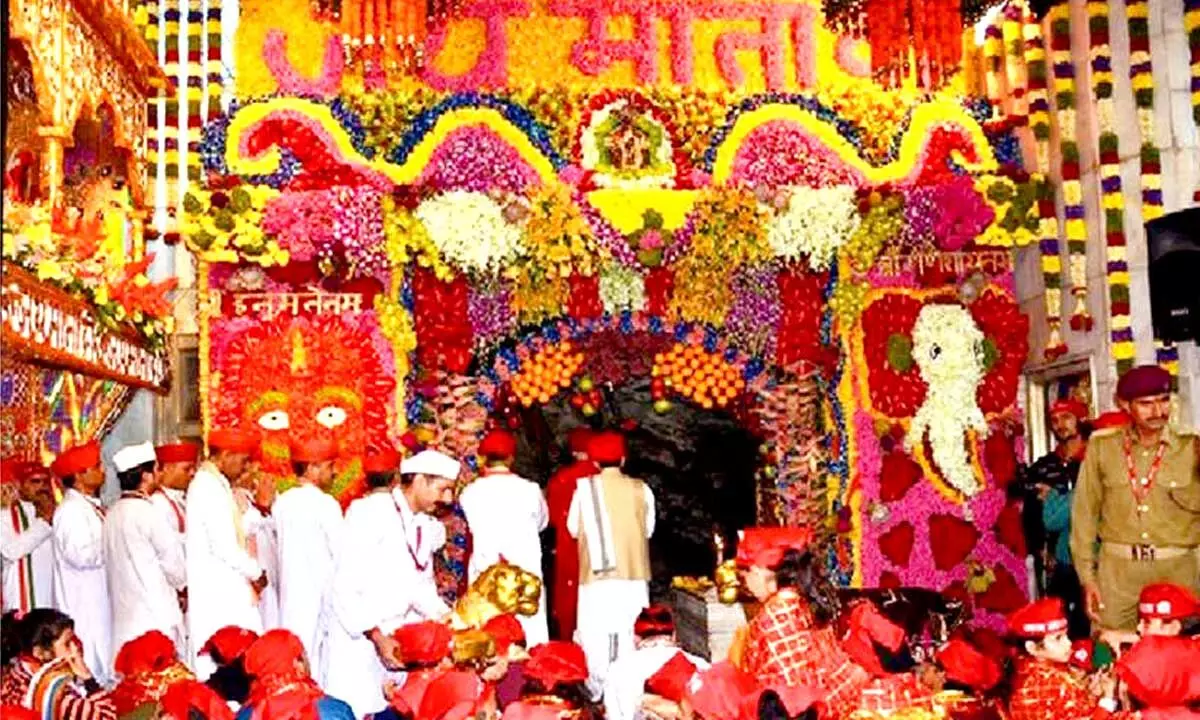HP’s floral tribute at Vaishno Devi, Brajeshwari Devi shrines

Trade insiders say the demand for flowers is very high for the decoration of the holy shrine of Mata Vaishno Devi that is considered the holiest of all Shakti Peeths, attracting nearly 30,000 devotees daily during the Navratri festivity
As the nine-day Shardiya Navratri -- a Hindu festival celebrated with fervour across India involving fasting and rituals -- continues, Himachal Pradesh’s flower fields are alive with the vibrant colours of marigolds
Shimla: As the nine-day Shardiya Navratri -- a Hindu festival celebrated with fervour across India involving fasting and rituals -- continues, Himachal Pradesh’s flower fields are alive with the vibrant colours of marigolds, dahlias, and calendulas, each bloom seemingly infused with a touch of the divine. India’s most prominent shrines, from the holiest three-peaked cave shrine of Mata Vaishno Devi in Trikuta Hills in Jammu and Kashmir’s Reasi district to Himachal’s Chintpurni to the hilltop Naina Devi and Brajeshwari Devi temples, are daily ordering the local blossoms in abundance, boosting the region’s floriculture sector as temples adorn their altars and pathways for grand floral decorations during the festival that will culminate on October 12.
“Our carnations are always in high demand during Navratri. This time we got bulk orders to decorate Shri Mata Vaishno Devi’s altars and pathways,” Naresh Thakur, a grower in the Churah valley in Himachal, told IANS over the phone.
He added, “We feel blessed as the flowers raised by our hands are used in the most revered shrine.”
Trade insiders say the demand for flowers is very high for the decoration of the holy shrine of Mata Vaishno Devi that is considered the holiest of all Shakti Peeths, attracting nearly 30,000 devotees daily during the Navratri festivity.
Functionaries with the Shri Mata Vaishno Devi Shrine Board say the one-km-long pathway to the shrine has been tastefully decorated with both indigenous and foreign fruits and fresh flowers.
Every day new flowers are added to the floral decorations. The exotic flowers have been procured from countries like Thailand, New Zealand and Holland.
The imported flowers include hydrangea mix colour, disbud yellow, king protea pink, cape bucket, hypericum berry red, bankasia mix, pincushion, cymbidium, tulip and phalaenopsis and they stay fresh for almost a fortnight.
The Indian flowers comprise roses in all colours, carnations, limoniums, orchids purple and green, daisies in all colours, chrysanthemums, gerberas, hydrangeas, Asiatic lily, green ball dianthus, celosia dark pink, yellow and red, snapdragon, yellow and white, and gypsophilas.
“Flowers like gladiolus, carnations and lilium normally stay fresh for almost a fortnight. Orange and yellow marigolds are specially procured from Kolkata as they have a long shelf-life. They all add to visual delight with the ‘darshans’ of the mother goddess on auspicious occasions like Shardiya and Chaitra Navratri,” a senior official with the Vaishno Devi Shrine Board told IANS, adding “even fruits like apples, mangoes, grapes, pomegranates, guavas, pineapples, mandarin oranges and pears are used to decorate the 96-foot-long main cave.”
For two-and-a-half decades, one out of the eight members of the Vaishno Devi Shrine Board takes on the responsibility of organising the grand floral and fruit decoration of the shrine complex on both occasions -- Shardiya and Chaitra Navratri.
This time 70 truckloads of flowers, procured from Bengaluru, Delhi and Kolkata, have been used for the decorations.
More than 450 workers have been deployed for the decoration of the entire complex. Designers from Kolkata and Uttar Pradesh were deployed for the decoration of cut-flowers and decorating ‘mehrabs’ and making floral designs.
This time the theme of Shardiya Navratri is ‘Balroop’ of the Mother Goddess. Likewise, the popular shrines in Himachal like the hilltop Naina Devi temple in Bilaspur district, Chintpurni in Una district and Jwalaji and Brajeshwari Devi temples in Kangra district, too, have been tastefully decorated with flowers. Flower growers in Sirmaur, Solan, Kullu, Chamba, Shimla, Mandi and Kangra get to work early in the morning and move through mist-laden fields, picking flowers while the dew still clings to the petals.















